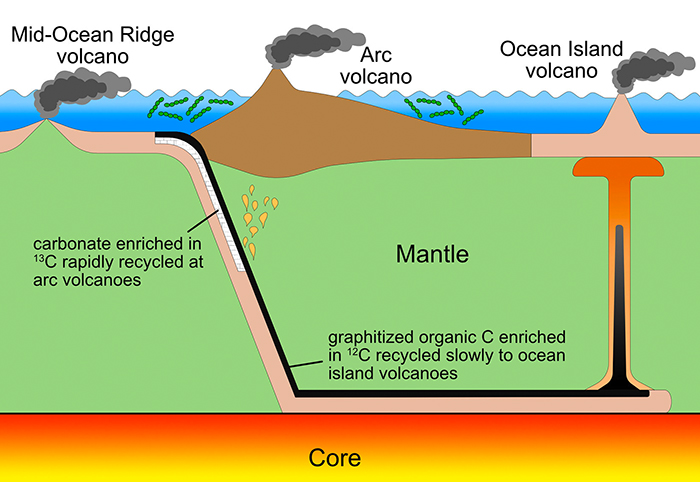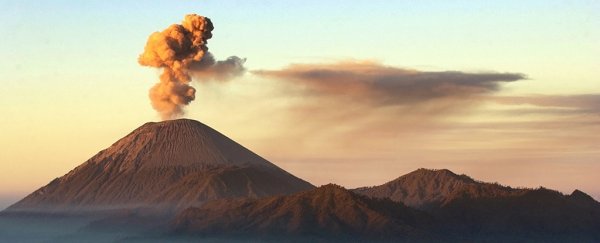These days, Earth's atmosphere is perfectly suited for us to breathe - but the air on our planet wasn't always this way.
Now, researchers have put forward a new explanation for the events that dramatically shifted that crucial composition of gasses.
According to the new study, a critical event in Earth's atmospheric history may have come in the form of volcanic eruptions, caused by shifting tectonic plates.
The planet's crust and mantle moved in a way that set off particular chemical reactions, resulting in a spike in oxygen production and laying the foundation for complex life on our planet.
The new model put forward by a Rice University-led team could help to explain not one, but two long-standing geological mysteries.
First, there's the Great Oxidation Event (GOE) of around 2.4 billion years ago, where oxygen levels rose sharply; then, the Lomagundi event, a significant shift in carbon isotope balances that happened about 100 million years later.
Carbon has three naturally occurring isotopes - variants that can be distinguished based on the number of neutrons they contain. The ratio of carbon-12 and carbon-13 isotopes is a useful tool for studying natural systems and the atmosphere, since the two variants tend to come from different sources.
The vast majority of carbon on Earth is carbon-12, but during the Lomagundi event there was a sudden spike in carbon-13 isotopes. Before now, researchers have found it tricky to fit the GOE and the Lomagundi event together in one coherent hypothesis.
"What makes this unique is that it's not just trying to explain the rise of oxygen," says geoscientist James Eguchi, from the University of California, Riverside.
"It's also trying to explain some closely associated surface geochemistry, a change in the composition of carbon isotopes, that is observed in the carbonate rock record a relatively short time after the oxidation event.
"We're trying to explain each of those with a single mechanism that involves the deep Earth interior, tectonics and enhanced degassing of carbon dioxide from volcanoes."
Before now, photosynthesis was thought to be the main driver of the GOE, as cyanobacteria pumped oxygen out as a waste product of just being alive. That still played a big part, the new research suggests, but much more was going on in our planet's interior.
 (J. Eguchi/University of California, Riverside)
(J. Eguchi/University of California, Riverside)
Based on detailed modelling, the scientists think that increased tectonic activity produced hundreds of new volcanoes ahead of the GOE, pumping masses of CO2 into the air. This warmed the climate, increasing rainfall and subsequent weathering, leading to more minerals being washed off rocks and into the ocean.
In turn, this triggered a boom in cyanobacteria and carbonates, with this extra organic and inorganic carbon getting recycled from the ocean floor into Earth's mantle. The rise in oxygen is accounted for in both the growth of cyanobacteria numbers (therefore increasing photosynthesis) and in the carbon being taken out of the atmosphere as it gets buried deep underground.
"It's kind of a big cyclic process," says Eguchi.
Crucially for the Lomagundi event calculations, the different chemical make-up of organic and inorganic carbon means they reappeared at different times, explaining the increase in carbon-13 with a 100-million-year gap.
Carbon rich in inorganic-derived carbon-13 isotopes would have reappeared first, through volcanoes directly above subduction zones, the areas where oceanic plates get dragged beneath continents. Meanwhile, carbon-12-rich carbon would have appeared later through other volcanic hotspots, having initially been sequestered much deeper underground.
Peering back this far into the past always involves a bit of educated guesswork, and more research is going to be needed to see if this new model stands up – but it's an intriguing look at how the serious atmospheric shifts of more than 2 billion years ago might have been triggered.
"We're proposing that carbon dioxide emissions were very important to this proliferation of life," says Eguchi. "It's really trying to tie in how these deeper processes have affected surface life on our planet in the past."
The research has been published in Nature Geoscience.
